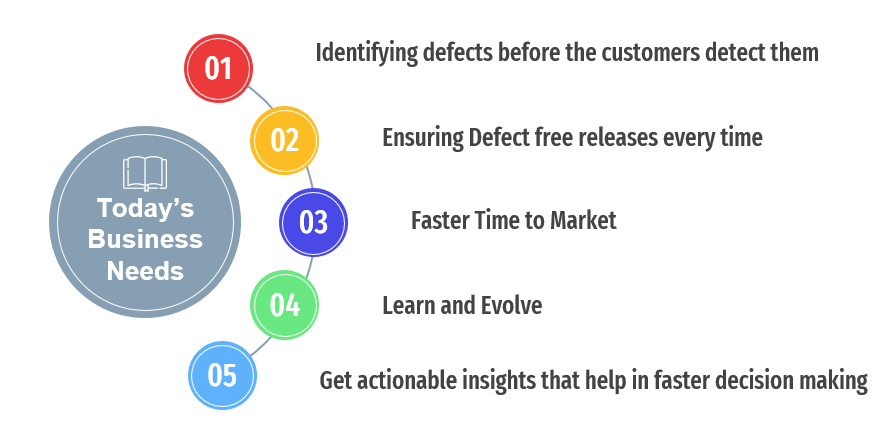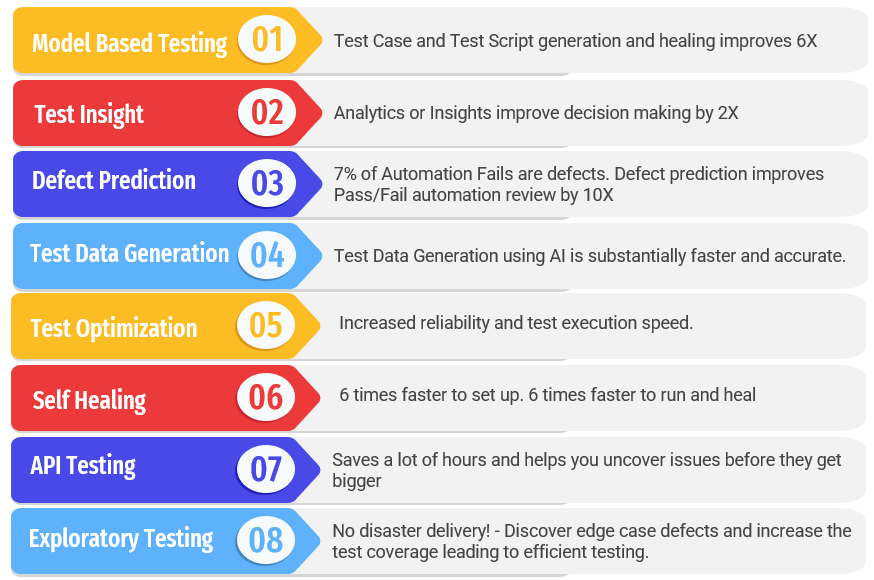Intelligent Test Automation is the new fuel to software testing – the use of Analytics, Artificial Intelligence, and Machine Learning makes smarter and intelligent decisions at a higher efficiency. To be future ready, you need to embrace innovative and intelligent trends and tools.
Now before we dive into the intelligent testing tools, we need to understand what are the latest trends in testing and why we need these.
This is the first article in the series that covers the trends, and then the second article covers the tools that will help us.
The Changing Landscape of Software Testing
From being a standalone activity at the end of the development cycle, Testing has come a long way and now it’s embedded throughout the software development pipeline. Time to market is a key imperative to succeed in today’s competitive world. Any tool can help you test your application, but there is more to effective testing than that.
The future of effective testing is dominated by the recent technological advancements in Artificial Intelligence (AI), Machine Learning (ML) and insight-driven methods that help you right from the planning stage till execution. With rapid advancements in AI and ML, the future of testing is also evolving.
Today’s business needs
Today’s businesses have realized that using AI-ML powered Test Automation Tools have major impacts on the business outcomes, they are time saving and help you with faster and better quality releases. The trends and tools will help you and the business by:

The current trends in AI Testing
Many organizations have made AI-driven transformations and are making significant progress in driving use cases at scale. In the sections below, we take the categories that Gartner depicts for employing Intelligent Test Automation in QA testing. Additionally, we have also added three more areas to expand the overall scope of Intelligent Test Automation.

Here are the current trends in AI testing that help deliver the business needs along with the delivery of flawless applications and enhanced user experience.
1. Model Based Testing continues to get better and better, decreasing the effort needed to create and maintain automation.
This is an application of model-based design where test scripts are automatically generated, executed, and checked based on formal specifications of the system under test.
Impact – Test Case and Test Script generation and healing improves 6X
2. Test Insight is moving into mainstream and can help you shape and measure your testing efforts, quality and product life cycle.
They help you with test insights into the entire CI/CD pipeline to understand the impact every change is having on the product and provide guidance and strategic benefits to test management.
Impact – Test Analytics or Insights improve decision making by 2X
3. Defect Prediction can help you save enormous amounts of time in diagnosing and triaging automation Pass/Fail.
Quality comes when you have proper defect triaging/reporting and no noise. The AI tools share an in-depth analysis of automation failures to help the teams reduce their triage time
Impact – 7% of Automation Fails are defects. Defect prediction improves Pass/Fail automation review by 10X
4. Test Data Generation is the biggest challenge for ensuring an excellent testing process and many companies have been focused in this area and rapid advancements are being achieved. With the power of AI and analytics, you can generate data that comes as close as possible to your production data without revealing any sensitive information.
The AI based tools help you analyze a UI and identify a series of test cases that predict the user behavior. It also updates your test data based on newly added functionalities to the system along with the ability to identify and prioritize the test cases for execution.
Impact – Test Data Generation using AI is substantially faster and accurate.
5. Test Optimization is making the test process efficient without any quality compromises.
To speed up and optimize the testing in agile and DevOps environments, World Quality Report recommends a new option – the use of AI to optimize test cases.
AI systems are ideal for determining the area to test as well as the method to test and to failover.
Impact – Increased reliability and test execution speed.
6. Self Healing is the need of the hour as It helps teams to move from defect-based resolution to real-time issue resolution. It’s the ability to update the test cases and test scripts when the UI or API changes.
The complexity of applications increases exponentially as new features are added to the existing functionality. The AI ML power combo can learn if there is a change made, and then automatically modify the test automation script to fix the problem.
Impact – 6 times faster to set up. 6 times faster to run and heal
7. API Testing is the latest trend in the testing community with organizations moving to cloud computing. as it emphasizes the testing of business logic, data responses and security, and performance bottlenecks. With teams moving to microservices architecture, the usage and testing of APIs are on the rise.
Impact – Saves a lot of hours and helps you uncover issues before they get bigger
8. Exploratory Testing has gathered momentum in recent years as it can help testers explore the application beyond the limits of scripted tests.
Exploratory Testing helps to reveal bugs that would go undiscovered during the structured phase of testing. It’s a simultaneous process where you can perform test design and test execution at the same time.
Impact – No disaster delivery! – Discover edge case defects and increase the test coverage leading to efficient testing.
Here’s an interesting whitepaper that talks about the software testing trends forecast and euphoria around Artificial Intelligence – Hype versus Reality. Along with the overall trends of Intelligent Test Automation that we just talked about, the paper dives into the insights and innovations developed by technologically dexterous companies and provides our estimate of the impact that using AI would have in the near term.
Conclusion
With applications becoming complex, teams often struggle with multiple challenges. For example, testing teams need to work collaboratively with the development team on every product release, identifying issues, and fixing them within timelines. With the world moving toward Agile and DevOps, the scalability to changing requirements becomes slow with inefficiencies and delays as teams lack necessary new-age technological skill sets.
With every organization embracing Artificial Intelligence and Machine Learning technologies, CI/CD model, Agile and DevOps practices across all domains, the push for high quality product releases through rapid release cycles are at an all time high. Hence, these next-generation trends are exceedingly important for teams and organizations to accelerate the testing process.
Now that you are aware of the latest trends, let’s look at the innovative tools that will help you jump start your testing.
If this has piqued your interest and you want to know more, then please click here and schedule a demo, or reach out to us at info@webomates.com.
If you like this blog series please like/follow us Webomates or Aseem.


No comments:
Post a Comment